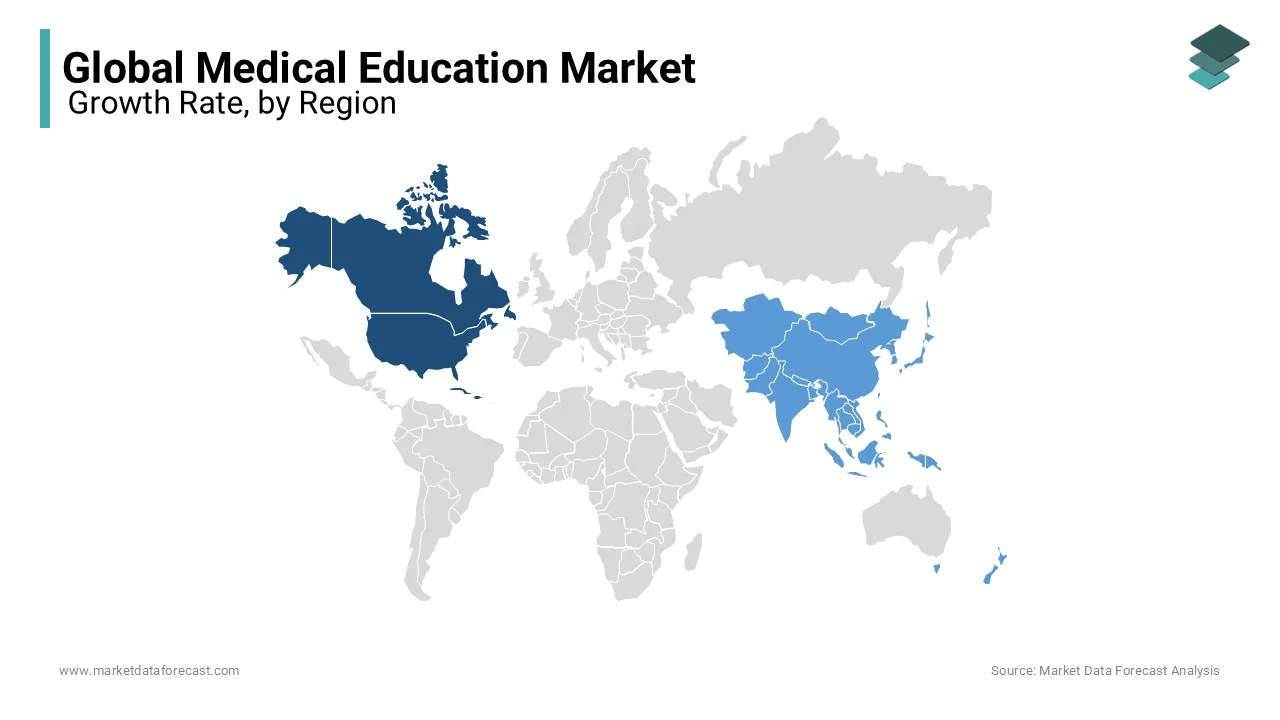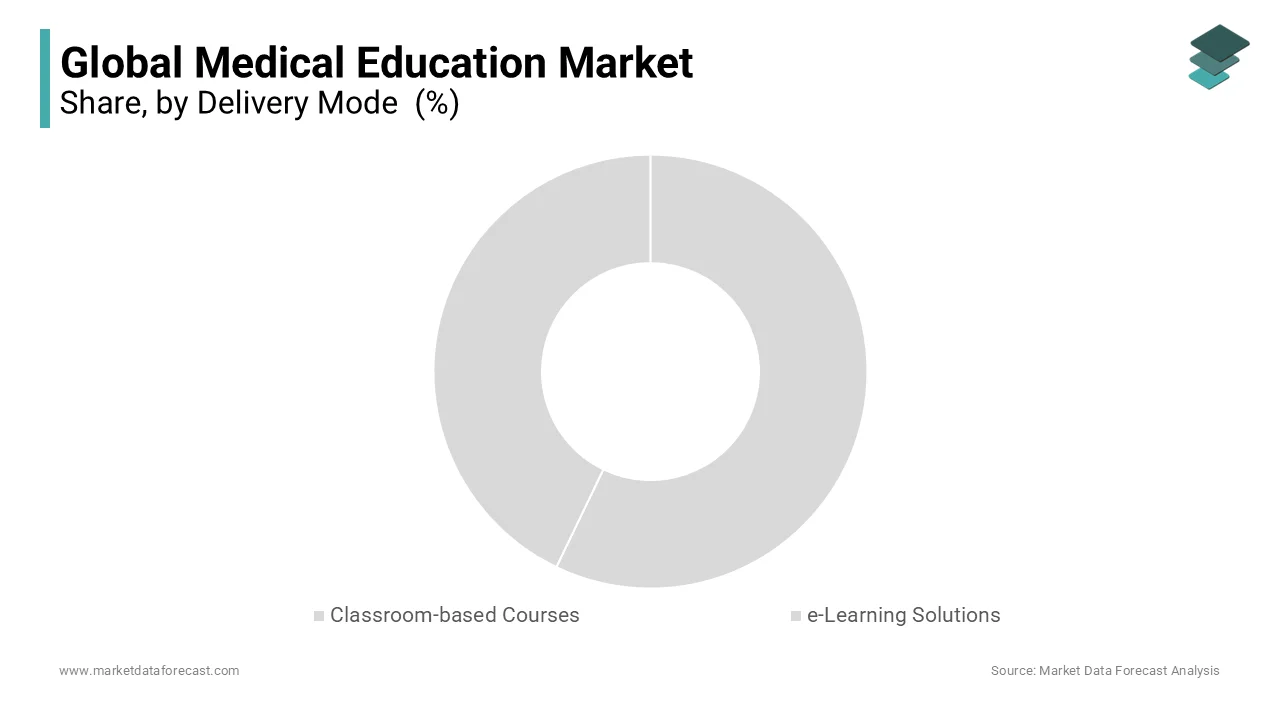Global Medical Education Market Size, Share, Trends & Growth Forecast Report By Providers (OEM/Pharmaceutical and Medical Device Companies, Universities and Academic Centres, Continued Medical Education Providers, Learning Management Systems Providers, Education Platforms, Professional Associations & Medical Simulation), Delivery Mode (Classroom-based Courses and e-Learning Solutions), Application (Cardiology, Internal Medicine, Radiology, Neurology, Pediatrics, Academic Education & Other Applications) and Region (North America, Europe, Asia Pacific, Latin America, Middle East & Africa), Industry Analysis From 2025 to 2033.
Global Medical Education Market Size
The size of the global medical education market was valued at USD 119 billion in 2024. The global market is anticipated to grow at a CAGR of 10.12% from 2025 to 2033 and be worth USD 283.4 billion by 2033 from USD 131.04 billion in 2025.
The World Health Organization (WHO) defines medical education as "any combination of learning opportunities aimed at assisting individuals and societies improve their health, whether through increased awareness or a shift in attitudes." Individuals or groups are educated about environmental health, physical health, social health, emotional health, intellectual health, dental health, and sexual and reproductive health education through medical education. Healthcare education activities include conferences, forums, workshops, seminars, webinars, and lectures to promote favorable health protection policies among the general public and legislators.
MARKET DRIVERS
Nowadays, technology in healthcare is altering, and practitioners must be prepared to keep up with the changing technologies. The ability to deliver services in a much shorter amount of time necessitates improvements in data, with all content, including patient literacy and medical records, being digital, which requires trained professionals, as it did with the transition from traditional hospital to ambulatory medicine. Diagnostics, laboratory investigations, medical discharge records, and hospital admissions, for instance, all demand expert people.
Furthermore, the automation of healthcare facilities, which involves using a variety of computer networks and software programs, demands staff training to increase service efficiency. In addition, public healthcare organizations require doctors, consultants, and medical specialists to be accredited in continuing medical education programs to use this system (CME). As a result, medical education is in more demand.
Traditional learning has some drawbacks. Building and running physical training facilities are expensive, and meet changing demands as disease therapies, medical technology, and drugs evolve at a rapid pace is challenging. eLearning addresses several of these issues by allowing physicians and other healthcare professionals to take lessons at their own pace. Through films and audios that are cost-effective, this online approach enables unprecedented access to innovative research approaches such as speed customization and collaborative learning. Anyone can utilize online learning to learn at any time and from any location because it has no boundaries. Medical professionals can use CME programs in both online and classroom settings, allowing them to fit learning into their busy schedules. Non-medical employees can also benefit from an e-learning strategy that does not disrupt their work.
MARKET RESTRAINTS
Unreliable and pricey facilities are impeding the growth of the global medical education market. Building classrooms and other structures are costly, and it has become more challenging as new technologies emerge. In addition, people with internet access problems can be found in various areas, affecting online health education. The situation is improving, however, thanks to government help.
REPORT COVERAGE
|
REPORT METRIC |
DETAILS |
|
Market Size Available |
2024 to 2033 |
|
Base Year |
2024 |
|
Forecast Period |
2025 to 2033 |
|
Segments Covered |
By Provider, Delivery Mode, Application, End-user, & Region |
|
Various Analyses Covered |
Global, Regional & Country Level Analysis, Segment-Level Analysis, DROC, PESTLE Analysis, Porter’s Five Forces Analysis, Competitive Landscape, Analyst Overview of Investment Opportunities |
|
Regions Covered |
North America, Europe, APAC, Latin America, Middle East & Africa |
|
Market Leaders Profiled |
ADP, Articulate, Central Michigan University College of Medicine, Cerner, Coursera, Elsevier, GE Healthcare, HealthcareSource, HealthStream, IBM, Infor, Koninklijke Phillips, Oracle, PeopleFluent, PfizerWebinar |
SEGMENTAL ANALYSIS
By Providers Insights
The universities and academic centers segment held the largest share of the medical education market. A significant element contributing to this segment's considerable share is the shortage of healthcare workers required to offer high-quality care.
By Delivery Mode Insights
The market for medical education solutions is dominated by e-learning solutions. Accessibility, cost reductions, more instructional resources, and a plethora of new improvements all contribute to the dominance. Students can also test out courses before purchasing them, allowing them to complete a program without paying for certification.
By Application Insights
The cardiology segment is expected to dominate the global medical education market during the forecast period. This segment likewise held the largest market share. The global market is expected to grow as a result of an increase in the number of initiatives taken by CME providers and key players to organize CME (Continuing Medical Education) activities, as well as an increase in the number of grants from government bodies to help young cardiologists access quality training.
REGIONAL ANALYSIS
In North America, the market is expected to grow at a CAGR of 9.7% during the forecast period. This is due to initiatives done by industry players and regional governments to increase the number of medical schools and develop the healthcare sector. An increase in the number of CME programs and significant governmental and corporate sector investments in developing young healthcare professionals are driving the expansion of the North American region. Physicians and non-physicians alike realize the value of continuing medical education (CME) solutions in keeping up with continuously changing technologies. The availability of adequate programs to train healthcare personnel for rising technology is driving the Medical Education industry in the area. Furthermore, due to public and private healthcare institutions' endeavors to train healthcare professionals for current technologies, medical education solutions are in great demand.

The Asia Pacific is expected to become a significant player in the medical education solutions market in the coming years. The region's healthcare education solutions market is being driven by rapid economic development in the region's emerging nations, including the expansion and modernization of healthcare. As a result, laboratory technicians, hospital floor supervisors, nurses, and operating room professionals in the region's modern healthcare institutions are increasingly tech-savvy. Furthermore, the region's market expansion is being fuelled by an increase in demand for online learning, a growing preference for ongoing medical education due to stringent regulatory requirements, and the utilization of current technology to meet training demands.
KEY MARKET PLAYERS
Academy of Medicine of Richmond, Adobe Inc., ADP, Articulate, Central Michigan University College of Medicine, Cerner, Coursera, Elsevier, GE Healthcare, HealthcareSource, HealthStream, IBM, Infor, Koninklijke Phillips, Oracle, PeopleFluent, PfizerWebinar, Siemens Healthineers, and Trivantis Corporation are some of the promising companies operating in the global medical education market profiled in this report.
RECENT HAPPENINGS IN THIS MARKET
- Keres launched a health education initiative with 'The Voice' winner Chevel Shepherd on April 30, 2023. Keres' No More New Mexico young adult initiative, which connects youth in the state with tobacco-free education and resources, is the focus of the collaboration.
- According to Rishihood University, the Rishihood School of Healthcare opened on November 26, 2020. The School of Healthcare provides various UG and PG degree programs in allied healthcare, including B.Sc. Cardiovascular Technology, Medical Laboratory Technology, and MBA in Healthcare Management.
MARKET SEGMENTATION
This report on the global medical education market has been segmented and sub-segmented into the provider, delivery mode, application, end-user, & region.
By Providers
- OEM/Pharmaceutical and Medical Device Companies
- Universities and Academic Centres
- Continued Medical Education Providers
- Learning Management Systems Providers
- Education Platforms
- Professional Associations
- Medical Simulation
By Delivery Mode
- Classroom-based Courses
- e-Learning Solutions
By Application
- Cardiology
- Internal Medicine
- Radiology
- Neurology
- Pediatrics
- Academic Education
- Other Applications
By End-User
- Physicians
- Non-Physician Healthcare Professional
- Students
By Region
- North America
- Europe
- Asia-Pacific
- Latin America
- The Middle East and Africa
Frequently Asked Questions
What is the present size of the medical education market?
The global medical education market is expected to be USD 119 billion in 2024
What factors are driving the growth of the medical education market?
The growth of the medical education market is driven by several factors, including the increasing demand for healthcare services, the need for specialized medical professionals, and the adoption of new technologies and teaching methods.
Who are the major players in the medical education market?
Some of the major players in the medical education market include Kaplan, Inc., Apollo Hospitals Education and Research Foundation, Harvard Medical School, Duke University School of Medicine, and Johns Hopkins School of Medicine.
What are some of the challenges facing the medical education market?
Some of the challenges facing the medical education market include the high cost of tuition and training, the need for continuous learning and professional development, and the limited availability of certain medical education resources and programs in some regions.
Related Reports
Access the study in MULTIPLE FORMATS
Purchase options starting from $ 2500
Didn’t find what you’re looking for?
TALK TO OUR ANALYST TEAM
Need something within your budget?
NO WORRIES! WE GOT YOU COVERED!
Call us on: +1 888 702 9696 (U.S Toll Free)
Write to us: [email protected]


